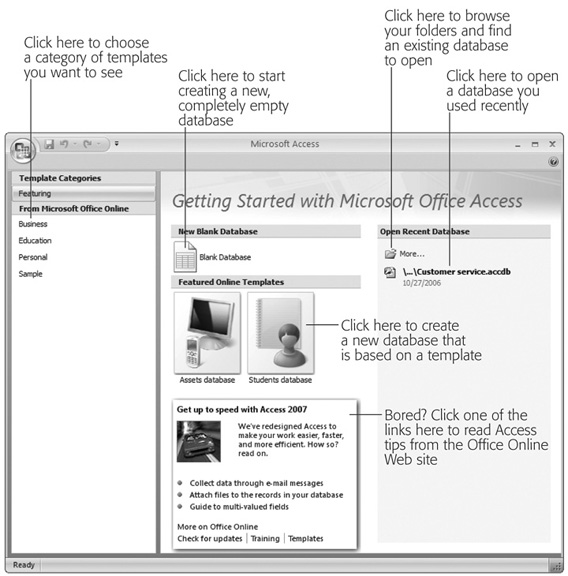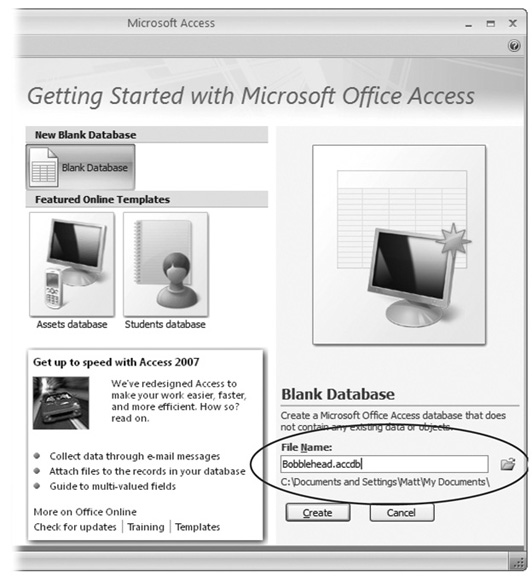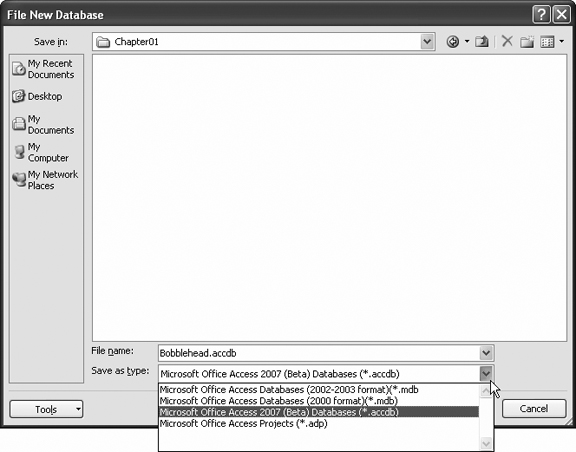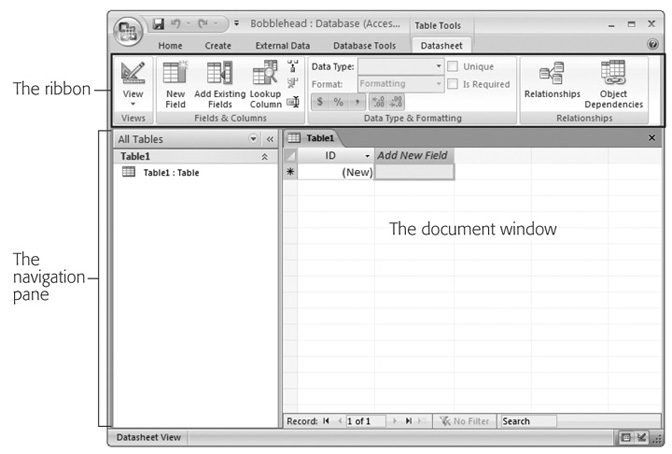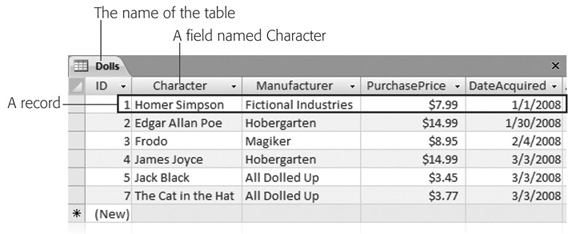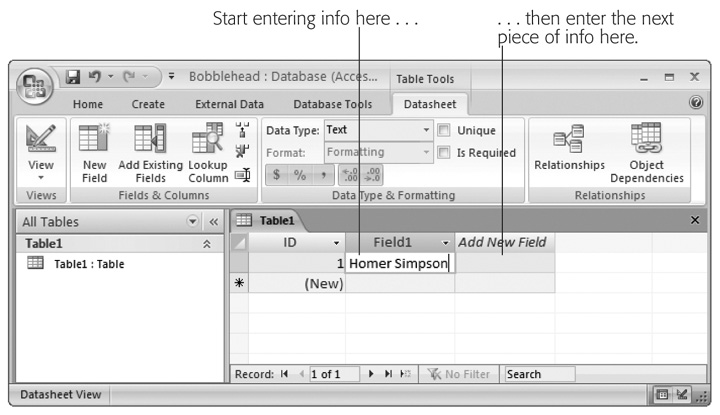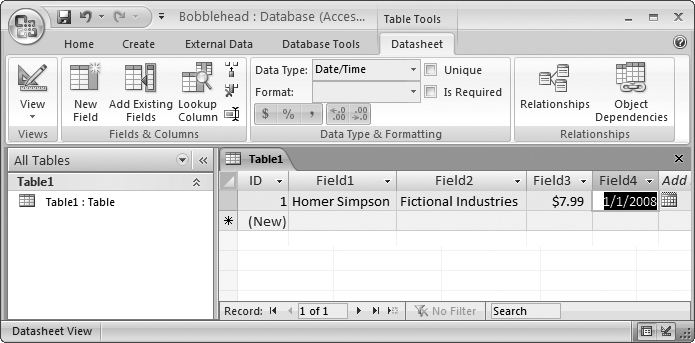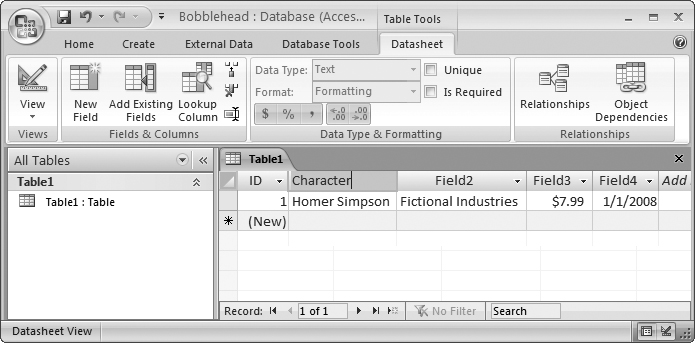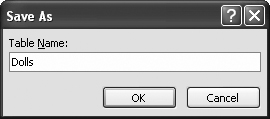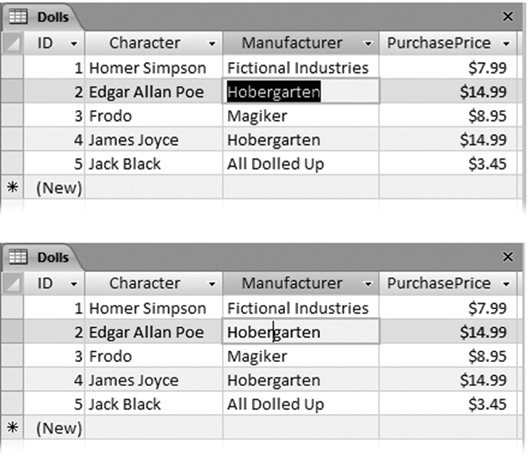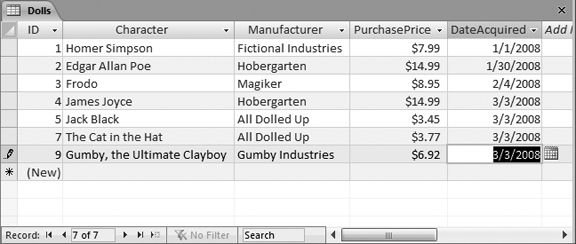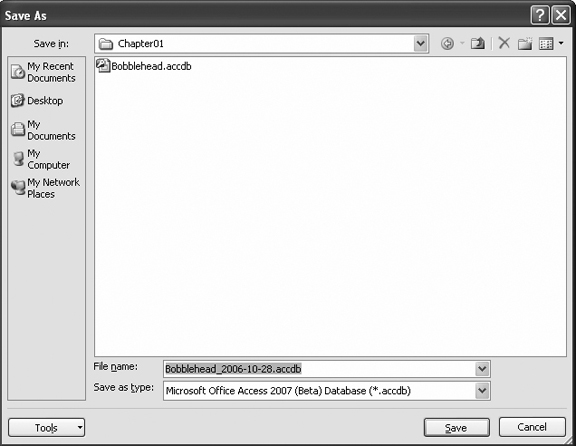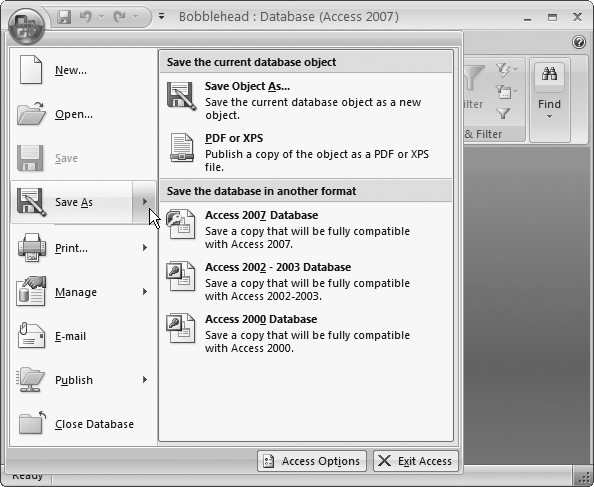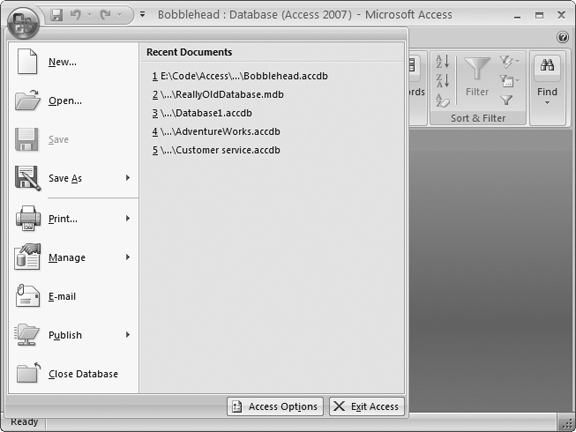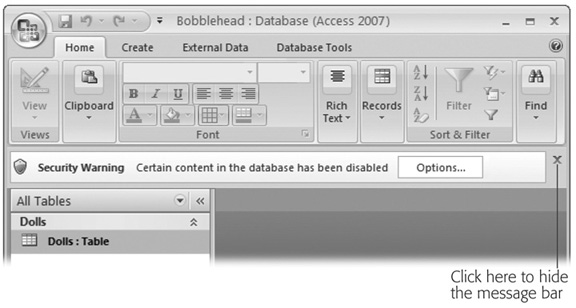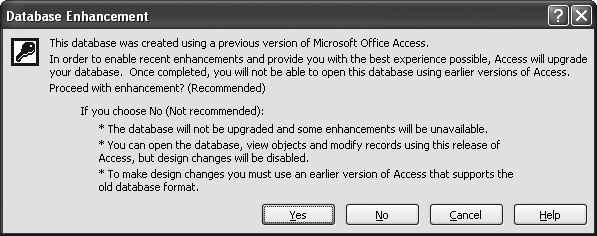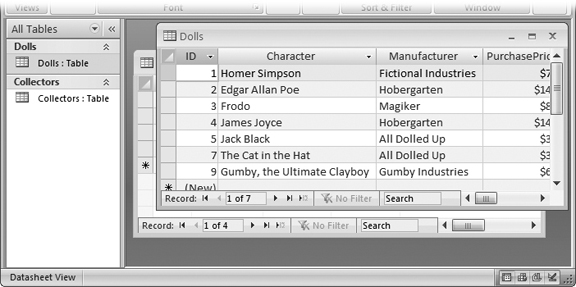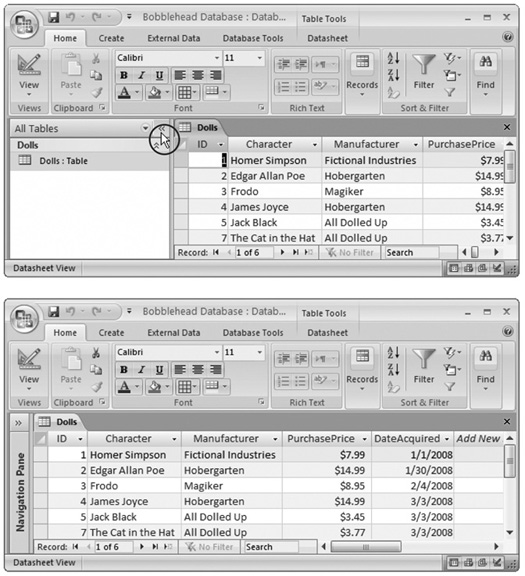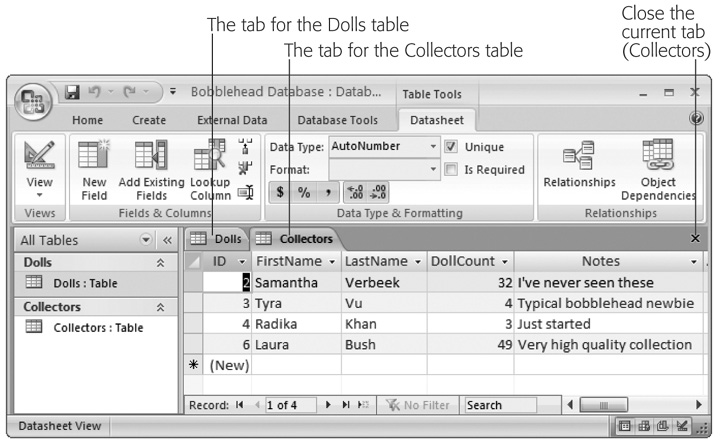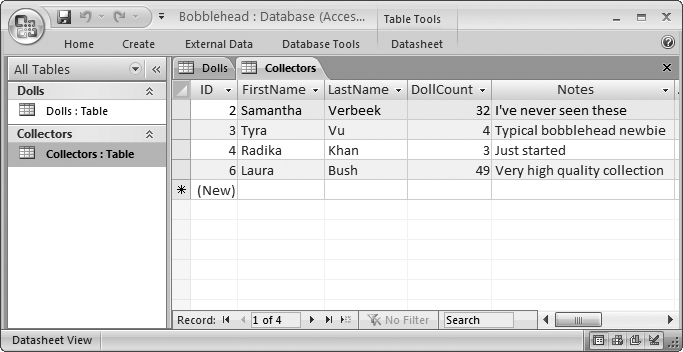Although Microsoft wonât admit it, Access can be intimidatingâintimidating enough to trigger a cold sweat in the most confident office worker. Even though Microsoft has spent millions making Access easier to use, most people still see it as the most complicated Office program on the block. Theyâre probably right.
Access seems more daunting than any other Office program because of the way that databases work. Quite simply, databases need strict rules. Other programs arenât as obsessive. For example, you can fire up Word, and start typing a letter straight away. Or you can start Excel, and launch right into a financial report. But Access isnât nearly as freewheeling. Before you can enter a stitch of information into an Access database, you need to create that databaseâs structure. And even after youâve defined that structure, youâll probably want to spend more time creating other useful tools, like handy search routines and friendly forms that you can use to simplify data lookup and data entry. All of this setup takes effort, and a good understanding of how databases work.
In this chapter, youâll conquer any Access resistance you have and learn to create a simple but functional database. Along the way, youâll get acquainted with the slick new Access user interface, and youâll learn exactly what you can store in a database. Youâll then be ready to tackle the fine art of database design, covered in more detail throughout this book.
As you already know, a database is a collection of information. In Access, every database is stored in a single file. That file contains database objects, which are simply the components of a database.
Database objects are the main players in an Access database. Altogether, you have six different types of database objects:
Tables store information. Tables are the heart of any database, and you can create as many tables as you need to store different types of information. A fitness database could track your daily running log, your inventory of exercise equipment, and the number of high-protein whey milkshakes you down each day, as three separate tables.
Queries let you quickly perform an action on a table. Usually, this action involves retrieving a choice bit of information (like the 10 top-selling food items at Edâs Roadside Dinner, or all the purchases you made in a single day). However, you can also use queries to apply changes.
Forms are attractive windows that you create, arrange, and colorize. Forms provide an easy way to view or change the information in a table.
Reports help you print some or all of the information in a table. You can choose where the information appears on the printed page, how itâs grouped and sorted, and how itâs formatted.
Macros are mini-programs that automate custom tasks. Macros are a simple way to get custom results without becoming a programmer.
Modules are files that contain Visual Basic code. You can use this code to do just about anythingâfrom updating 10,000 records to firing off an email. (Chapter 16 has the full story on Visual Basic.)
Access gurus refer to all these database ingredients as objects because you manage them all in essentially the same way. If you want to use a particular object, then you add it to your database, give it a name, and then fine-tune it. Later on, you can view your objects, rename them, or delete ones you donât want anymore.
Tip
Designing a database is the process of adding and configuring database objects. For those keeping score, an Access database can hold up to 32,768 separate objects.
In this chapter, youâll consider only the most fundamental type of database object: tables. But first, you need to learn a bit more about databases and the Access environment.
Itâs time to begin your journey and launch Access. Youâll start at a spiffy Getting Started page (Figure 1-1).
Figure 1-1. The Getting, Started page is a bit of a cross between a Windows program and a Web page. Use the links on the left to browse through different categories of templates (ready-to-go databases that you can download and fill with your own information). Or check out the links on the bottom, which show you the latest Access news and tips.
The Getting Started page looks a little dizzying at first glance, but it really serves just three purposes:
It shows you recent content from Microsoftâs Office Online Web site. For example, you can read helpful articles about Access, find timesaving tips, or download updates. All links open in a separate browser window.
It lets you open a database you used recently. Look for the Open Recent Database section on the right, which gives you a list.
It lets you create a new database. You can start off with an empty database (use the Blank Database button), or you can try to find a ready-made template that fits the bill.
You may think that it would be nice to customize the Getting Started page. Access does let you do so, but itâs not all that easyâand itâs recommended only for organizations that want to standardize the Getting Started page to better suit their employees. A business could add links to a company Web site or a commonly used database template. If youâre interested in this feature, youâll need another tool: the freely downloadable Access Developerâs Toolkit, which you can search for at http://msdn.microsoft.com. (This tool wasnât yet released at the time of this writing.)
The Getting Started page is only the front door to the features in Accessâthereâs lot more in store once you get rolling. You wonât be able to try out other parts of the Access until you create a new database, and the next section shows you how.
In this chapter, youâll slap together a fairly straightforward database. The exampleâs designed to store a list of prized bobblehead dolls. (For those not in the know, a bobblehead doll is a toy figure with an outsize head on a spring, hence the signature âbobblingâ motion. Bobblehead dolls usually resemble a famous celebrity, politician, athlete, or fictional character.)
Tip
You can get the Bobblehead database, and all the databases in this book, on the Web. Check out Section 3.4.2.3 in the Introduction for more details.
Hereâs how to create a blank new database:
On the Getting Started page, click the Blank Database button.
A side panel appears on the right (see Figure 1-2).
Type in a file name.
Access stores all the information for a database in a single file with the extension. accdb (which stands for Access database). Donât stick with the name Access picks automatically (like Database1.accdb). Instead, pick something more suitable. In this example, Bobblehead.accdb does the trick.
As with any other file, Access files can contain a combination of letters, spaces, numbers, parentheses, hyphens (-), and the underscore (_). Itâs generally safest to stay away from other special characters, some of which arenât allowed.
Note
Depending on your computer settings, Windows may hide file extensions. Instead of seeing the Access database file MyScandalousWedding.accdb in file-browsing tools like Windows Explorer, you may just see the name MyScandalousWedding (without the .accdb part on the end). In this case, you can still tell the file type by looking at the icon. If you see a small Access icon next to the file name (which looks like a key), thatâs your signal that youâre looking at an Access database. If you see something else (like a tiny paint palette), you need to make a logical guess about what type of file it is.
Choose a folder.
Like all Office programs, Access assumes you want to store every file you create in your personal My Documents folder. If this isnât the case, click the folder icon to show the File New Database dialog box, browse to the folder you want (Figure 1-3), and then click OK.
Click the Create button (at the bottom-right of the Access window).
Access creates your database file and then pops up a datasheet where you can get to work creating your first table.
Once you create or open a database, the Access window changes quite a bit. An impressive-looking toolbar (the ribbon) appears at the top of your screen, and a navigation pane shows up on the left. Youâre now in the control center where youâll perform all your database tasks (as shown in Figure 1-4).
The Introduction covers the basics of how the ribbon works. (Jump to Section 3.2 for the full details.) But first, itâs time to consider how you can make use of your brand-new, empty database by adding a table.
Figure 1-3. The File New Database dialog box lets you choose where youâll store a new Access database file. It also gives you the option to create your database in the format used by previous versions of Access (.mdb). To do so, you need to choose either the 2000 or 2002-2003 format options from the âSave as typeâ list, as shown here. If youâre running Windows Vista, youâll notice that the File New Database dialog box has a whole different look, but all the same features.
Figure 1-4. The navigation pane on the left lets you see different items (or objects) in your database. You can use the navigation pane to jump from a list of products to a list of customers and back again. The ribbon along the top groups together every Access command. This ribbonâs the mission control that lets you perform various tasks with your database. The document window in the middle takes up the rest of the window. This windowâs where youâll do your work, such as designing tables and entering data.
Tables are information containers. Every database needs at least one tableâwithout it, you canât store any data. In a simple database, like the Bobblehead database, a single table (which weâll call Dolls) is enough. But if you find yourself wanting to store several lists of related information, then you need more than one table. In the database BigBudgetWedding.accdb, you might want to keep track of the guests that you invited to your wedding, the gifts that you requested, and the loot that you actually received. In Chapter 5, youâll see plenty of examples of databases that use multiple tables.
Figure 1-5 shows a sample table.
Figure 1-5. In a table, each record occupies a separate row. Each field is represented by a separate column. In this table, itâs clear that youâve added six bobblehead dolls. Youâre storing information for each doll in five fields (ID, Character, Manufacturer, PurchasePrice, and DateAcquired).
Before you start designing this table, you need to know some very basic rules:
A tableâs nothing more than a group of records . A recordâs a collection of information about a single thing. In the Dolls table, for example, each record represents a single bobblehead doll. In a Family table, each record would represent a single relative. In a Products table, each record would represent an item thatâs for sale. You get the idea.
Each recordâs subdivided into fields . Each field stores a distinct piece of information. For example, in the Dolls table, one field stores the person on whom the dollâs based, another field stores the price, another field stores the date you bought it, and so on.
Tables have a rigid structure. In other words, you canât bend the rules. If you create four fields, every record must have four fields (although itâs acceptable to leave some fields blank if they donât apply).
When you first create a database, itâs almost empty. But in order to get you started, Access creates your first database objectâa table named Table1. The problem is, this table begins life completely blank, with no defined fields (and no data).
If you followed the steps to create a new database (Section 1.2.1), youâre already at the Datasheet view (Figure 1-5), which is where you enter data into a table. All you need to do is customize this table so that it meets your needs.
There are two ways to customize a table:
Design view lets you precisely define all aspects of a table before you start using it. Almost all database pros prefer Design view, and youâll start using it in Chapter 2.
Datasheet view is where you enter data into a table. Datasheet view also lets you build a table on the fly as you insert new information. Youâll use this approach in this chapter.
The following steps show you how to turn a blank new table (like Table1) into the Dolls table using the Datasheet view:
To define your table, you need to add your first record.
In this case, that means mentally picking a bobblehead doll to add to the list. For this example, youâll use a nifty Homer Simpson replica.
In the datasheetâs Add New Field column, type the first piece of information for the record (see Figure 1-6).
Based on the simple analysis you performed earlier (Section 1.2.3), you know that you need to enter four fields of information for every doll. For the Homer Simpson doll, this information is: âHomer Simpsonâ (the name), âFictional Industriesâ (the manufacturer), $7.99 (the price), and todayâs date (the purchase date). Although you could start with any field, it makes sense to begin with the name, which is clearly an identifying detail.
Figure 1-6. To fill in your first record, start by entering something in the first field of information (like the doll name âHomer Simpsonâ). Then, hit Tab to jump to the second column, and then enter the second piece of information. Ignore the ID column for nowâAccess adds that to every table to identify your rows.
Press Tab to move to the next field, and return to step 2.
Repeat steps 2 and 3 until youâve added every field you need, being careful to put each separate piece of information into a different column.
If you want to get a little fancier, include the currency symbol ($) when you enter the price, and make sure you put the data in a recognized date format (like January 1, 2008 or 01-01-2008). These clues tell Access what type of information youâre putting in the column. (In Chapter 2, youâll learn how to take complete control of the type of data in each column and avoid possible misunderstandings.) Figure 1-7 shows the finalized record.
Note
If you hit Tab without entering any information, youâll move to the next row and start inserting a new record. If you make a mistake, you can backtrack using the arrow keys.
Figure 1-7. The only problem with the example so far is that as you enter a new record, Access creates spectacularly useless field names. Youâll see its choices at the top of each column (theyâll have names like Field1, Field2, Field3, and so on). The problem with using these meaningless names is that they might lead you to enter a piece of information in the wrong place. You could all too easily put the purchase price in the date column. To prevent these slip-ups, you need to set better field names.
Itâs time to fix your column names. Double-click the first column title (like Field1).
The field name switches into Edit mode.
Type in a new name, and then press Enter. Return to step 4.
Repeat this process until youâve cleaned up all the field names. The proper field names for this example are Character, Manufacturer, PurchasePrice, and Date-Acquired. Figure 1-8 shows how it works.
Figure 1-8. To choose better field names, double-click the column title. Next, type in the real field name, and then press Enter. Section 2.5.1 has more about field naming, but for now just stick to short, text-only titles that donât include any spaces, as shown here.
Choose Office button â Save (or use the Ctrl+S shortcut) to save your table.
Access asks you to supply a table name (see Figure 1-9).
Type a suitable table name, and then click OK.
Congratulations! The tableâs now a part of your database.
Figure 1-9. A good table nameâs a short text title that doesnât have any spaces (like Dolls here).
Note
Technically, you donât need to save your table right away. Access prompts you to save it when you close the datasheet (by clicking the X at the document windowâs top-right corner), or when you close Access.
As you can see, creating a simple table in Access is almost as easy as laying out information in Excel or Word. If youâre itching to try again, you can create another table in your database by choosing Create â Table from the ribbon. But before you get to that stage, it makes sense to take a closer look at how you edit your table.
You now have a fully functioning (albeit simple) database, complete with one table, which in turn contains one record. Your next stepâs filling your table with useful information. This often-tedious process is data entry.
To fill the Dolls table, you use the same datasheet you used to define the table. You can perform three basic tasks:
Editing a record. Move to the appropriate spot in the datasheet (using the arrow keys or the mouse), and then type in a replacement. You may also want to use Edit mode, which is described in the next section.
Inserting a new record. Move down to the bottom of the table, to the row that has an asterisk (*) on the left. This row doesnât actually exist until you start typing in some information. At that point, Access creates the row and moves the asterisk down to the next row underneath. You can repeat this process endlessly to add as many rows as you want (Access can handle millions).
Deleting a record. You have several ways to remove a record, but the easiest is to right-click the margin immediately to the left of the record, and then choose Delete Record. Access asks you to confirm that you really want to remove the selected record, because you canât reverse the change later on.
Youâll probably spend a lot of time working with the datasheet. So settle in. To make your life easier, it helps to understand a few details.
As you already know, you can use the arrow keys to move from field to field or row to row. However, you might have a bit of trouble editing a value. When you start typing, Access erases any existing content. To change this behavior, you need to switch into Edit mode by pressing the F2 key; in Edit mode, your typing doesnât delete the stuff thatâs already in that field. Instead, you get to change or add to it. To switch out of Edit mode, you press F2 again. Figure 1-10 shows a closeup look at the difference.
Figure 1-10. Top: Normal mode. If you start typing now, youâll immediately erase the existing text (âHobergartenâ). The fact that all the text in the fieldâs selected is a big clue that youâre about to wipe it out. Bottom: Edit mode. The cursor shows where youâre currently positioned in the current field. If you start typing now, youâll insert text in between âHoberâ and âgartenâ.
Edit mode also affects how the arrow keys work. In Edit mode, the arrow keys move through the current field. For example, to move to the next cell, you need to move all the way to the end of the current text, and then press the right arrow (â) key again. But in Normal mode, the arrow keys always move you from cell to cell.
Power users know the fastest way to get work done is to use tricky keyboard combinations like Ctrl+Alt+Shift+*. Although you canât always easily remember these combinations, a couple of tables can help you out. Table 1-1 lists some useful keys that can help you whiz around the datasheet.
Table 1-1. Keys for Moving Around the Datasheet
Table 1-2. lists some convenient keys for editing records.
Table 1-2. Keys for Editing Records
|
Key |
Result |
|---|---|
|
Esc |
Cancels any changes youâve made in the current field. This key works only if you use it in Edit mode. Once you move to the next cell, change is applied. (For additional cancellation control, try the Undo feature, described next.) |
|
Reverses the last edit. Unfortunately, the Undo feature in Access isnât nearly as powerful as it is in other Office programs. For example, Access allows you to reverse only one change, and if you close the datasheet, you canât even do that. You can use Undo right after you insert a new record to remove it, but you canât use the Undo feature to reverse a delete operation. | |
|
Copies a value from the field thatâs immediately above the current field. This trickâs handy when you need to enter a batch of records with similar information. Figure 1-11 shows this often-overlooked trick in action. | |
|
Inserts todayâs date into the current field. The date formatâs based on computer settings, but expect to see something like 24-12-2007. Youâll learn more about how Access works with dates in Section 2.3.5. | |
|
Inserts the default value for the field. Youâll learn how to designate a default value in Section 4.1.2. |
Access, like virtually every Windows program, lets you cut and paste bits of information from one spot to another. This trickâs easy using just three shortcut keys: Ctrl+C to copy, Ctrl+X to cut (similar to copy, but the original contentâs deleted), and Ctrl+V to paste. When youâre in Edit mode, you can use these keys to copy whatever youâve selected. If youâre not in Edit mode, the copying or cutting operation grabs all the content in the field.
Unlike other programs, Access doesnât require that you save your work. It automatically saves any changes you make.
When you create a new database (Section 1.2.1), Access saves your database file. When you add a table or another object to the database, Access saves the database again. And when you enter new data or edit existing data, Access saves the database almost instantaneously.
This automatic save process takes place behind the scenes, and you probably wonât notice anything. But donât be alarmed when you exit Access and it doesnât prompt you to save changes, as all changes are saved the moment you make them.
The automatic save feature can pose a problem if you make a change mistakenly. If youâre fast enough, you can use the Undo feature to reverse your last change (Figure 1-12). However, the Undo feature reverses only your most recent edit, so itâs no help if you edit a series of records and then discover the problem. It also doesnât help if you close your table and then reopen it.
Figure 1-12. The Undo command appears in the Quick Access toolbar at the top left of the Access window (circled), so itâs always available.
For these reasons, itâs a good idea to make frequent database backups. To make a database backup, you simply need to copy your database file to another folder, or make a copy with another name (like Bobblehead_Backup1.accdb). You can perform these tasks with Windows Explorer, but Access gives you an even easier option. Just choose Office button â Manage â Back Up Database, and Access creates a copy of your database for you, in the location you choose (Figure 1-13).
Note
Itâs still up to you to remember to back up your database. Access doesnât include an automatic backup feature, but you can use another tool to periodically copy your database file. One example is the Windows Task Scheduler thatâs included with most versions of Windows. (You can read a quick no-nonsense Task Scheduler tutorial at http://www.pctechguide.com/tutorials/ScheduleTasks.htm.)
If you decide you want to save your database with a different name, in a different place, or using an older Access file format, you can use the trusty Save As command. Begin by choosing Office button â Save As, and then use one of the options in Figure 1-14. Keep in mind that, once Access creates the new database file, that fileâs the one it keeps using. In other words, when you create a table or edit some data, Access updates the new file. (If you want to go back to the old file, you either need to open it in Access, or use Save As again.)
Figure 1-14. Make sure you click the rightpointing arrow next to the Save As menu command to see this submenu of choices. (Just clicking Save As performs the default option, which saves a copy of the currently selected database object, not your entire database.) Then, choose one of the options under the âSave the database in another formatâ heading.
Once youâve created a database, itâs easy to open it later. You can use any of these approaches:
Double-click a database file. (You can browse to it using My Computer, Windows Explorer, or just plop in on your desktop.) Remember, Access databases have the file extension .accdb or .mdb.
Launch Access, and then look for your database in the Open Recent Database section on the right of the Getting Started page. (The same listâs available through the Office menu, as shown in Figure 1-15.)
Launch Access, choose Office button â Open, and then browse for your Access database file.
Figure 1-15. The Office menuâs Recent Documents list has the same list of files as the Open Recent Database section on the Getting Started page. But if you already have a database open, the Recent Documents listâs more convenient, because you donât need to head back to the Getting Started page.
When you open a database, youâll notice something a little bizarre. Access pops up a message bar with a scary-sounding security warning (Figure 1-16).
Figure 1-16. This security warning tells you that Access doesnât trust your databaseâin other words, itâs opened your file in a special safe mode that prevents your database from performing any risky operations.
The security warningâs a bit confusing, because right now your database doesnât even attempt to do anything risky. However, once you start building databases with code routines (as described in Part Five) or when you start using action queries (Chapter 8), itâs a different story. At that point, you may want to reconfigure Access so it recognizes your files and learns to be a bit more trusting.
In the meantime, youâre probably wondering what you should do about the message bar. You have two options:
Click the X at the right side of the message bar to banish it. (Itâll reappear the next time you open the database.)
Tell Access that it can trust your databases by designating a trusted locationâa folder on your hard drive where you store your database files. Youâll learn how to set up a trusted location in Section 15.2.4.
Every time you use the Office button â Open command, Access closes the current database, and then opens the one you chose. If you want to see more than one database at a time, you need to fire up more than one copy of Access at the same time. (Computer geeks refer to this action as starting more than one instance of a program.)
Itâs almost embarrassingly easy. If you double-click another database file while Access is already open, then a second Access window appears in the taskbar for that database. You can also launch a second (or third, or fourthâ¦) instance of Access from the Start menu, and then use Office button â Open to load up a different database in each one.
You can use the Office button â Open command to open an Access database that somebody created with a previous version of Access. (See the box âSharing Databases with Older Versions of Accessâ in Section 1.2.2 for more about different Access file formats.)
Access handles old database files differently, depending on just how old they are. Hereâs how it works:
If you open an Access 2002-2003 file, you donât get any notification or warning. Access keeps the current format, and youâre free to make any changes you want.
If you open an Access 2000 file, youâre also in for smooth sailing. However, if you change the design of the database, the new parts you add may not be accessible in Access 2000.
If you open an older Access file (like one created for Access 97, 95, or 2.0), Access asks whether you want to convert the database or just open it (see Figure 1-17).
Figure 1-17. Access gives you a choice when you open a database file that was created in Access 97, 95, or 2.0. If you choose to convert the database (click Yes), Access copies the existing database into a new database file, in Access 2002-2003 format. You can then edit this copy normally. If you choose to open the database (click No), Access opens the original file without making a copy. You can still edit existing data and add new data, but you canât change the databaseâs design.
Tip
You can always tell the current databaseâs format by looking at the text in brackets in the Access windowâs title bar. If you open an Access 2002-2003 file, the title bar might read âBobblehead: Database (Access 2002-2003 file format)â.
When you open an old-school Access database, youâll notice something else has changed. When you open a table, it wonât appear in a tabbed window (like the ones shown in Figure 1-20). Instead, the table opens in an ordinary window that can float wherever it wants inside the main Access window. This seems fine at first, until you open several tables at once. Then, youâre stuck with some real clutter, as shown in Figure 1-18.
Figure 1-18. In an old-style Access database, different windows can overlap each other. Itâs not long before the table you want is buried at the bottom of a stack of windows.
This somewhat unfriendly behavior is designed to be more like previous versions of Access. But donât worryâyou can get back to the slick tabs even if you donât convert your database to the new format. All you need to do is set a single configuration option for your database:
Choose Office button â Access Options. The Access Options window appears.
In the list on the left, choose Current Database.
Under the Application Options heading, look for the Document Windows Options setting, where you can choose Overlapping Windows (the Access 2003 standard) or Tabbed Windows (the wave of the future).
Click OK.
Close and open your database so the new setting takes effect.
For a retro touch, you can use the same setting to make a brand new Access database use overlapping windows instead of tabs.
Creating a new database is the easiest task yet. You simply need to choose Office button â New. Access takes you back to the Getting Started page, where you can create a blank database by clicking the familiar Blank Database button, as described earlier (Section 1.2.1).
Itâs time to step back and take a look at what youâve accomplished so far. Youâve created the Bobblehead database, and added a single database object: a table named Dolls. Youâve filled the Dolls table with several records. You donât have the fancy windows, reports, and search routines that make a database work really smoothly, but you do have the most important ingredientâorganized data.
One issue you havenât tackled yet is how you manage the objects in your database. For example, if you have more than one table, you need a way to move back and forth between the two. That toolâs the navigation pane, shown in Figure 1-19.
Figure 1-19. Unhappy with the space consumed by the navigation pane? Click the Open/Close button in the top-right corner (top), and the navigation bar slides out of the way to give more room for the datasheet (bottom). Click the button again to expand it back into view.
The navigation pane shows the objects (Section 1.2) that are part of your database, and it lets you manipulate them. However, you donât necessarily see all your database objects at all times. The navigation pane has several different viewing modes, so you can home in on exactly what interests you.
When you first create a database, the navigation pane shows only the tables in your database. Thatâs good enough for nowâafter all, your database doesnât contain anything but the tables youâve created. (Youâll learn how to customize the navigation pane in Chapter 14.)
To really try out the navigation pane, you need a database with more than one table. To give it a whirl, choose Create â Table from the ribbon to add a new blank table. Follow all the steps in Section 1.2.3 to define the table and insert a record or two.
Tip
Not sure what table to create? Try creating a Collectors table that tracks all the friends you know who share the same bobbleheaded obsession. Now try to come up with a few useful fields for this table (while remembering that thereâs no need to go crazy with the details yet), and then compare your version to the example in Figure 1-20.
Once youâve added the new table, you see both the new table and the old in the navigation pane at the same time. If you want to open a table, then, in the navigation pane, just double-click it. If you have more than one datasheet open at once, then Access organizes them into tabs (see Figure 1-20).
Figure 1-20. Using the navigation pane, you can open as many tables at once as you want. Access gives each datasheet a separate tabbed window. To move from one window to another, you just click the corresponding tab. If youâre feeling a bit crowded, just click the X at the far right of the tab strip to close the current datasheet.
If you open enough tables, eventually all the tabs you need wonât fit. In this situation, Access adds tiny scroll buttons to the left and right of the tab strip. You can use these buttons to move through all the tabs, but it takes longer.
Figure 1-21. Do you want to use every square inch of screen space for your data? You can collapse the ribbon (as shown here) by double-clicking any tab. Click a tab to pop it open temporarily, or double-click a tab to bring the ribbon back for good. And if you want to perform the same trick without raising your fingers from the keyboard, then you can use the shortcut key Ctrl+F1.
So far, you know how to open a table using the navigation pane. However, opening tables isnât all you can do with the navigation pane. You can actually perform three more simple tasks with any database object that shows up in the navigation pane:
Rename it. Right-click the object, and then choose Rename. Then, type in the new name, and then press Enter. Go this route if you decide your Dolls table would be better off named DollsInMyWorldRenownedCollection.
Create a copy. Right-click the object, and then choose Copy. Right-click anywhere in the navigation pane, and then choose Paste. Access prompts you to supply the new copyâs name. The copy-an-object featureâs useful if you want to take an existing table and try redesigning it, but youâre not ready to remove the original copy just yet.
Delete it. Right-click the object, and then choose Delete. Access asks you to confirm this operation, because you canât reverse it.
Access gives you a few more options for transferring database objects and tucking them out of sight. Youâll consider these features later in the book.
Get Access 2007: The Missing Manual now with the O’Reilly learning platform.
O’Reilly members experience books, live events, courses curated by job role, and more from O’Reilly and nearly 200 top publishers.
